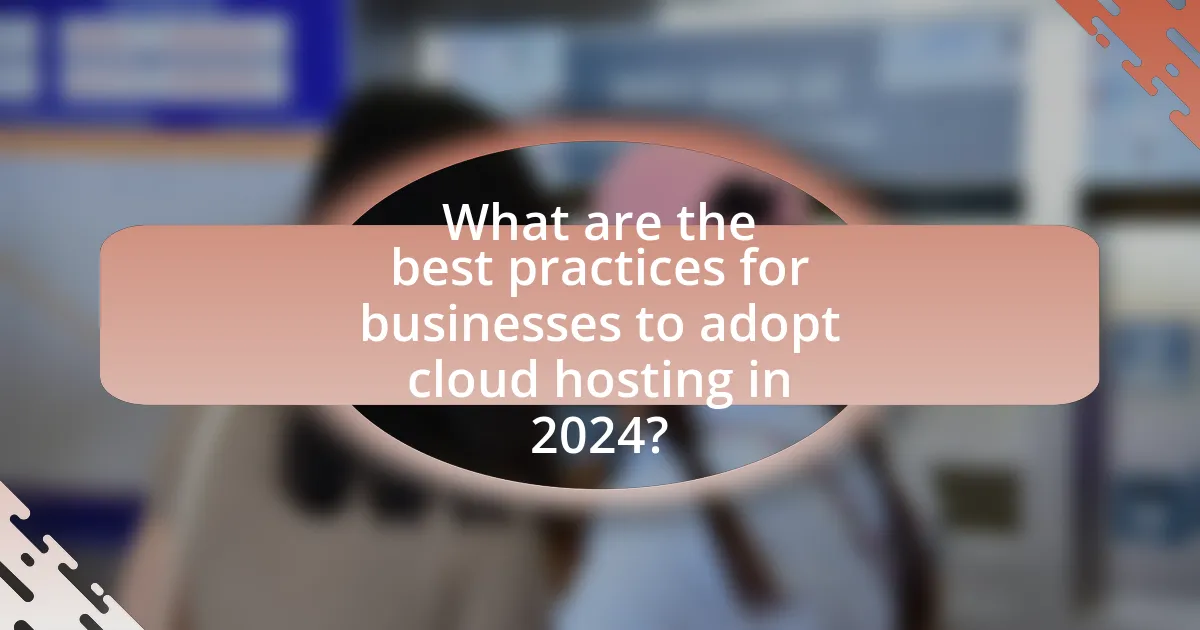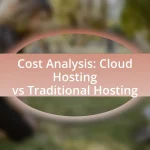The article focuses on the future of cloud hosting, highlighting key trends expected to shape the industry in 2024. It discusses the increasing adoption of multi-cloud strategies, enhanced security measures, and the rise of serverless computing, driven by the demand for scalability and cost efficiency. The article also examines the evolving customer expectations, the impact of artificial intelligence and edge computing on cloud solutions, and the importance of compliance with regulations. Additionally, it outlines best practices for businesses transitioning to cloud hosting, emphasizing the need for robust security, effective cost management, and strategies to avoid vendor lock-in.

What are the key trends shaping the future of cloud hosting in 2024?
The key trends shaping the future of cloud hosting in 2024 include increased adoption of multi-cloud strategies, enhanced security measures, and the rise of serverless computing. Multi-cloud strategies allow organizations to leverage multiple cloud providers for flexibility and redundancy, with 81% of enterprises reportedly using a multi-cloud approach according to a 2023 report by Flexera. Enhanced security measures are driven by the growing threat landscape, prompting cloud providers to invest in advanced security protocols and compliance certifications. Additionally, serverless computing is gaining traction as it enables developers to focus on code without managing infrastructure, with the serverless market projected to grow significantly, reaching $21.1 billion by 2025 as per a report by MarketsandMarkets.
How is the demand for cloud hosting evolving in 2024?
The demand for cloud hosting is expected to grow significantly in 2024, driven by increasing adoption of digital transformation initiatives across various industries. According to a report by Gartner, the global public cloud services market is projected to reach $600 billion by 2024, reflecting a compound annual growth rate of 18%. This growth is fueled by businesses seeking scalable, flexible, and cost-effective solutions to support remote work, data storage, and application deployment. Additionally, the rise of artificial intelligence and machine learning applications is further propelling the need for robust cloud infrastructure, as organizations require enhanced computing power and storage capabilities to process large datasets efficiently.
What factors are driving increased adoption of cloud hosting services?
Increased adoption of cloud hosting services is primarily driven by the need for scalability, cost efficiency, and enhanced security. Organizations are increasingly seeking flexible solutions that allow them to scale resources up or down based on demand, which cloud hosting provides effectively. According to a report by Gartner, 70% of organizations plan to increase their cloud spending in 2024, highlighting the trend towards cost-effective resource management. Additionally, advancements in security protocols and compliance measures have made cloud hosting more appealing, as businesses prioritize data protection and regulatory adherence.
How are businesses adapting to changing cloud hosting needs?
Businesses are adapting to changing cloud hosting needs by implementing hybrid cloud solutions that combine public and private cloud resources. This approach allows organizations to enhance flexibility, optimize costs, and improve data security. According to a report by Gartner, 81% of enterprises have adopted a multi-cloud strategy, indicating a significant shift towards utilizing multiple cloud services to meet diverse operational requirements. Additionally, businesses are increasingly leveraging automation and AI-driven tools to manage cloud resources efficiently, which helps in scaling services dynamically based on demand. This trend reflects the growing need for agility and responsiveness in a rapidly evolving digital landscape.
What technological advancements are influencing cloud hosting?
Technological advancements influencing cloud hosting include artificial intelligence, edge computing, and serverless architecture. Artificial intelligence enhances cloud services by automating resource management and optimizing performance, as evidenced by AI-driven tools that predict usage patterns and adjust resources accordingly. Edge computing reduces latency by processing data closer to the source, which is critical for applications requiring real-time data processing, such as IoT devices. Serverless architecture allows developers to build and run applications without managing servers, leading to increased efficiency and cost savings, as demonstrated by platforms like AWS Lambda, which charges only for the compute time consumed. These advancements collectively drive innovation and efficiency in cloud hosting environments.
How is artificial intelligence impacting cloud hosting solutions?
Artificial intelligence is significantly enhancing cloud hosting solutions by optimizing resource management and improving security protocols. AI algorithms analyze usage patterns to allocate resources dynamically, ensuring efficient performance and cost-effectiveness. For instance, according to a report by Gartner, AI-driven automation in cloud services can reduce operational costs by up to 30%. Additionally, AI enhances security by identifying and mitigating threats in real-time, as evidenced by a study from McKinsey, which found that AI can improve threat detection rates by 50%. These advancements illustrate how AI is transforming cloud hosting into a more efficient and secure environment.
What role does edge computing play in the future of cloud hosting?
Edge computing significantly enhances cloud hosting by reducing latency and improving data processing efficiency. As more devices connect to the Internet of Things (IoT), the demand for real-time data processing increases, necessitating a shift from centralized cloud models to decentralized edge computing solutions. According to a report by Gartner, by 2025, 75% of enterprise-generated data will be created and processed outside centralized data centers, underscoring the critical role of edge computing in future cloud hosting strategies. This shift allows for faster response times and reduced bandwidth costs, making cloud services more efficient and scalable.
What are the emerging security challenges in cloud hosting?
Emerging security challenges in cloud hosting include data breaches, misconfigured cloud settings, and inadequate access controls. Data breaches are increasingly common, with reports indicating that 60% of organizations experienced a cloud-related security incident in the past year. Misconfigured cloud settings often lead to unauthorized access, as evidenced by the fact that 70% of cloud security failures are attributed to misconfigurations. Inadequate access controls further exacerbate these issues, with studies showing that 90% of organizations do not enforce strict identity and access management policies. These challenges highlight the need for enhanced security measures in cloud environments.
How can businesses mitigate risks associated with cloud hosting security?
Businesses can mitigate risks associated with cloud hosting security by implementing robust security measures such as encryption, multi-factor authentication, and regular security audits. Encryption protects sensitive data both in transit and at rest, making it unreadable to unauthorized users. Multi-factor authentication adds an additional layer of security by requiring multiple forms of verification before granting access. Regular security audits help identify vulnerabilities and ensure compliance with industry standards, reducing the likelihood of data breaches. According to a 2022 report by the Cloud Security Alliance, organizations that adopt these practices experience 50% fewer security incidents compared to those that do not.
What compliance regulations should cloud hosting providers be aware of in 2024?
Cloud hosting providers in 2024 should be aware of several key compliance regulations, including the General Data Protection Regulation (GDPR), the Health Insurance Portability and Accountability Act (HIPAA), and the Federal Risk and Authorization Management Program (FedRAMP). GDPR mandates strict data protection and privacy standards for handling personal data of EU citizens, while HIPAA sets requirements for safeguarding medical information in the healthcare sector. FedRAMP provides a standardized approach to security assessment, authorization, and continuous monitoring for cloud services used by federal agencies. These regulations are critical as they ensure data security, privacy, and compliance with legal standards, which are increasingly scrutinized in the cloud hosting industry.

How are customer expectations changing in cloud hosting services?
Customer expectations in cloud hosting services are increasingly focused on enhanced performance, security, and flexibility. As businesses migrate to cloud solutions, they demand faster response times and higher uptime guarantees, with many providers now offering Service Level Agreements (SLAs) that promise 99.99% uptime. Additionally, security has become a paramount concern, with customers expecting robust data protection measures, including encryption and compliance with regulations like GDPR. Flexibility is also critical, as organizations seek scalable solutions that can adapt to their changing needs, leading to a rise in demand for customizable service plans. According to a 2023 report by Gartner, 70% of organizations prioritize cloud service providers that offer advanced security features and flexible pricing models, highlighting the shift in customer expectations towards comprehensive, secure, and adaptable cloud hosting solutions.
What do customers prioritize when choosing cloud hosting providers?
Customers prioritize reliability, security, scalability, and cost-effectiveness when choosing cloud hosting providers. Reliability is crucial as customers seek providers that ensure high uptime and consistent performance; for instance, a study by Gartner indicates that 99.9% uptime is a standard expectation. Security is also a top concern, with data breaches costing companies an average of $3.86 million, according to IBM’s Cost of a Data Breach Report. Scalability allows businesses to adjust resources based on demand, which is essential for growth; a Flexera report highlights that 58% of organizations prioritize this feature. Lastly, cost-effectiveness is vital, as companies aim to optimize their budgets while still receiving quality service, with 30% of businesses citing pricing as a key factor in their decision-making process.
How important is customer support in the cloud hosting decision-making process?
Customer support is critically important in the cloud hosting decision-making process. Effective customer support can significantly influence user satisfaction and retention, as studies show that 70% of customers are willing to pay more for better service. Additionally, reliable support can minimize downtime and operational disruptions, which are crucial for businesses relying on cloud services. According to a survey by Gartner, 80% of organizations consider customer support a key factor when selecting a cloud provider, highlighting its role in ensuring a smooth user experience and addressing technical issues promptly.
What features are customers looking for in cloud hosting solutions?
Customers are looking for scalability, reliability, security, and cost-effectiveness in cloud hosting solutions. Scalability allows businesses to adjust resources based on demand, ensuring optimal performance during peak times. Reliability is crucial, as customers expect minimal downtime and consistent service availability; for instance, leading providers often guarantee 99.9% uptime. Security features, including data encryption and compliance with regulations like GDPR, are essential to protect sensitive information. Lastly, cost-effectiveness is a priority, with customers seeking transparent pricing models that align with their budget and usage patterns. These features collectively enhance user experience and operational efficiency in cloud hosting.
How is pricing evolving in the cloud hosting market?
Pricing in the cloud hosting market is evolving towards more competitive and flexible models, driven by increased demand and technological advancements. Major providers like Amazon Web Services, Microsoft Azure, and Google Cloud are introducing pay-as-you-go pricing, which allows customers to pay only for the resources they use, thus reducing costs for businesses. Additionally, the rise of multi-cloud strategies is prompting providers to offer more attractive pricing packages to retain customers. According to a report by Synergy Research Group, the cloud infrastructure market grew by 35% year-over-year in 2023, indicating a strong competitive landscape that influences pricing strategies.
What pricing models are becoming popular among cloud hosting providers?
Usage-based pricing models are becoming increasingly popular among cloud hosting providers. This model allows customers to pay only for the resources they consume, which aligns costs with actual usage and can lead to significant savings for businesses. According to a report by Gartner, over 70% of organizations are expected to adopt usage-based pricing for cloud services by 2024, reflecting a shift towards more flexible and scalable financial structures in cloud computing. Additionally, subscription-based models, which offer predictable monthly fees for a set amount of resources, continue to be favored for their simplicity and ease of budgeting.
How do pricing strategies affect customer choices in cloud hosting?
Pricing strategies significantly influence customer choices in cloud hosting by determining perceived value and affordability. Customers often compare pricing tiers, such as pay-as-you-go versus subscription models, which directly impacts their decision-making process. For instance, a study by Gartner indicates that 70% of organizations prioritize cost when selecting cloud services, highlighting the importance of competitive pricing. Additionally, transparent pricing structures can enhance trust and lead to higher customer retention rates, as evidenced by a report from Forrester, which found that clear pricing information increases customer satisfaction by 30%. Thus, effective pricing strategies not only attract customers but also foster long-term loyalty in the cloud hosting market.

What are the best practices for businesses to adopt cloud hosting in 2024?
The best practices for businesses to adopt cloud hosting in 2024 include conducting a thorough needs assessment, selecting the right cloud service model, ensuring robust security measures, and implementing a comprehensive migration strategy. Conducting a needs assessment allows businesses to identify specific requirements and workloads suitable for cloud hosting, which is essential for optimizing performance and cost. Choosing the appropriate cloud service model—Infrastructure as a Service (IaaS), Platform as a Service (PaaS), or Software as a Service (SaaS)—is crucial for aligning with business goals and operational needs.
Security measures must be prioritized, as 2024 is expected to see increased cyber threats; implementing multi-factor authentication, data encryption, and regular security audits can mitigate risks. A well-defined migration strategy, including phased migration and staff training, ensures a smooth transition to the cloud, minimizing downtime and disruption. According to a report by Gartner, 85% of organizations will adopt a cloud-first strategy by 2025, highlighting the importance of these best practices for successful cloud adoption.
How can businesses effectively transition to cloud hosting?
Businesses can effectively transition to cloud hosting by conducting a thorough assessment of their current IT infrastructure and identifying specific needs and goals for cloud adoption. This involves evaluating existing applications, data storage requirements, and compliance issues to determine the most suitable cloud model—public, private, or hybrid.
Additionally, businesses should develop a clear migration strategy that includes selecting a reliable cloud service provider, planning for data migration, and ensuring minimal disruption to operations. According to a report by Gartner, 81% of enterprises have a multi-cloud strategy, indicating that businesses often benefit from leveraging multiple cloud environments to optimize performance and cost.
Training staff on new cloud technologies and implementing robust security measures are also critical steps in the transition process. Research from McKinsey shows that organizations that prioritize change management during cloud migration are 3.5 times more likely to achieve their objectives.
What steps should be taken to ensure a smooth migration to the cloud?
To ensure a smooth migration to the cloud, organizations should follow a structured approach that includes assessment, planning, execution, and optimization. First, conducting a thorough assessment of current infrastructure and applications is essential to identify which workloads are suitable for migration. Next, organizations must develop a detailed migration plan that outlines timelines, resource allocation, and risk management strategies. During execution, utilizing automated tools can streamline the migration process and minimize downtime. Finally, after migration, continuous optimization and monitoring of cloud resources are crucial to ensure performance and cost-effectiveness. According to a report by Gartner, organizations that follow a structured migration strategy can reduce migration-related issues by up to 30%.
How can businesses optimize their cloud hosting environments for performance?
Businesses can optimize their cloud hosting environments for performance by implementing auto-scaling, utilizing content delivery networks (CDNs), and optimizing resource allocation. Auto-scaling allows businesses to automatically adjust their resources based on demand, ensuring that performance remains consistent during peak usage times. CDNs enhance performance by distributing content closer to users, reducing latency and load times. Additionally, optimizing resource allocation through monitoring tools helps identify underutilized resources, enabling businesses to reallocate or downsize, which can lead to cost savings and improved performance. According to a study by Gartner, organizations that effectively utilize auto-scaling can achieve up to 30% better resource efficiency, demonstrating the tangible benefits of these optimization strategies.
What common pitfalls should businesses avoid in cloud hosting?
Businesses should avoid underestimating security risks in cloud hosting. Many organizations mistakenly believe that cloud providers handle all security measures, leading to vulnerabilities. According to a 2022 report by McAfee, 52% of organizations experienced a cloud-related security incident, highlighting the importance of implementing robust security protocols and maintaining oversight. Additionally, businesses often overlook the need for proper cost management, which can result in unexpected expenses; a study by Flexera found that 61% of organizations exceeded their cloud budgets. Lastly, neglecting to plan for data migration can lead to significant downtime and data loss, as evidenced by a 2021 survey from CloudEndure, which indicated that 70% of businesses faced challenges during cloud migration.
How can businesses prevent vendor lock-in when using cloud hosting services?
Businesses can prevent vendor lock-in when using cloud hosting services by adopting a multi-cloud strategy. This approach involves utilizing multiple cloud service providers to distribute workloads, which reduces dependency on a single vendor. Additionally, businesses should prioritize the use of open standards and APIs, enabling easier data migration and integration across different platforms. According to a 2022 report by Gartner, organizations that implement multi-cloud strategies can achieve up to 30% cost savings and increased flexibility, further validating the effectiveness of this approach in mitigating vendor lock-in risks.
What are the risks of underestimating cloud hosting costs?
Underestimating cloud hosting costs can lead to significant financial strain on businesses. When organizations fail to accurately predict expenses, they may encounter unexpected charges that exceed their budget, resulting in cash flow issues. For instance, a study by Gartner indicates that 70% of organizations overspend on cloud services due to a lack of visibility and control over their usage. Additionally, underestimating costs can hinder scalability, as businesses may find themselves unable to invest in necessary resources or upgrades when needed. This miscalculation can also lead to reduced competitiveness, as companies may struggle to keep pace with technological advancements and customer demands.
What practical tips can help businesses maximize their cloud hosting experience?
To maximize their cloud hosting experience, businesses should implement a multi-cloud strategy, which allows them to leverage the strengths of different cloud providers. This approach enhances flexibility, reduces vendor lock-in, and optimizes costs by allowing businesses to choose the best services for their specific needs. According to a 2023 report by Gartner, organizations using a multi-cloud strategy can reduce costs by up to 30% while improving performance and reliability. Additionally, businesses should prioritize security by adopting robust encryption and compliance measures, as data breaches can lead to significant financial losses and reputational damage. A study by IBM found that the average cost of a data breach in 2023 was $4.45 million, underscoring the importance of proactive security measures. Lastly, regular performance monitoring and optimization of cloud resources can lead to improved efficiency and cost savings, as businesses can adjust their usage based on real-time data and trends.


